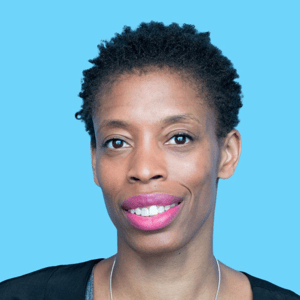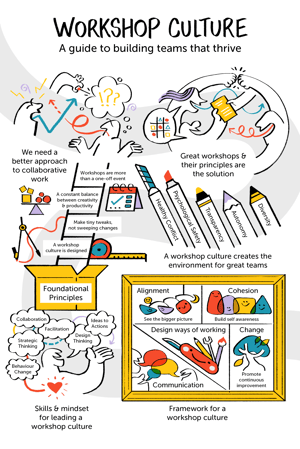Visualising Workshops: Q&A with facilitator Alison Coward
It's been ten years since Scriberia first worked with the brilliant Alison Coward. Founder of Bracket, a team culture consultancy, she is now the author of a new book, too: Workshop Culture: A guide to building teams that thrive. We caught up with Alison ahead of its publication to discuss, amongst other things, why visuals make for more productive workshops.
As a long-standing partner of Bracket, Scriberia have been lucky enough to have a ringside seat at many of Alison's innovative workshops, designed to build high-performing team cultures and resilient, future-proof teams. Alison has also delivered a number of workshops to our own (high-performing, resilient and future-proof!) team, so it's fair to say that we believe in her methods, just as she believes in ours. But, on the eve of her book launch, we couldn't resist the opportunity to ask why she believes visuals add real value to the workshop experience.
 When did you start using visualisation within your workshops?
When did you start using visualisation within your workshops?
If you want to have a productive discussion and to make sure that the discussion translates into something useful to your business - not just lots of hot air - it needs to be captured. It needs to be made tangible. Graphic facilitation - or scribing - is just an amazing way of doing that.
Coming across a company like Scriberia that can work with text and images is just so powerful. I work with them when the workshop or event we are running needs that ‘lift’ and the client wants something that will really capture the discussion that they can send round to attendees or to delegates afterwards.
Has your creative background shaped your approach to your work?
I'm not a creative myself but I've always worked in the creative sector and, for me, one of things that I've always been very passionate about is creative collaboration. How do you bring individual talents together into a team that creates something new? That's where I think visuals are great - where they can document conversations in a creative way; in a way that really resonates with creative, visual thinkers.
Can you think of a time when using visuals in your work has had a big impact?
I worked with an agency that wanted to really explore their company values. They wanted employees to think about what their values meant in daily practice and capture that in a form they could refer back to. After all, it can be very easy for teams and companies to come up with their values - ‘We are collaborative’ or ‘We are innovative’ - but it’s much harder to define what they actually mean and properly embed them? So we worked with the team to clearly define these concepts and translate them into visuals that they could refer back to. So they weren’t just words on the wall, they became a lot more real within the business.
How do you find visualisation helps when you’re running a workshop full of different personalities, seniorities and abilities?
Visualisation levels the playing field. People like to contribute in different ways; they may be happy to speak up or perhaps they prefer to write things down to post it up on a wall. But through visualisation, you can demonstrate that everyone’s ideas have been heard and captured, however they choose to contribute. There's something really powerful about someone, especially someone who doesn't often speak up in front of others, seeing something that they said captured in a visual way, within a really powerful image. It just elevates them to know ‘my contribution was valuable, it was heard and I'm valued’.
You've mentioned you largely work with creative and tech companies. Could this approach work across the board or is it creative industry-specific?
I actually think it's even more powerful when used outside of the creative industries; there can be almost a ‘distance’ from working visually. In environments where communication tends to be written or verbal, visual communication can be even more powerful because there's a freshness to it.
So perhaps helps exercise a part of the brain not normally used?
People often see creativity and productivity as opposing forces - creativity is messy and chaotic and productivity is about implementation and getting things done and clear - but I see them on a continuum, with creativity at one end and productivity at the other. Visual facilitation captures those ideas at the creative end of the continuum and makes them real and tangible so they can be delivered and implemented. So it really does bring those opposing forces of creativity and productivity together.
 You have a new book coming out - what's it all about and why did you write it?
You have a new book coming out - what's it all about and why did you write it?
The book is titled, 'Workshop Culture: A guide to building teams that thrive' and, in a nutshell, it is about how we can take the principles of collaborative workshops and infuse them into the rest of our culture. One of the things I've observed throughout my career is that people turn up to workshops expecting to work in a different way, expecting to have really productive, collaborative discussions, get stuck in and be creative. I've always found it a shame when we end the session and people go back to their desks and they've forgotten how they were in that workshop. So the book looks at what we can learn from workshops to build high performing team cultures outside of these.
Workshop Culture: A guide to building teams that thrive by Alison Coward, out November 21, 2023, Practical Inspiration Publishing, £12.65

